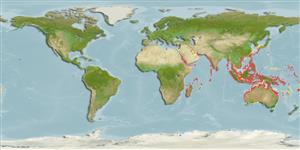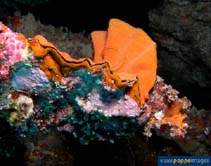Lopha cristagalli (Linnaeus, 1758)
Cock's comb oyster| Native range | All suitable habitat | Point map | Year 2050 |

|
| This map was computer-generated and has not yet been reviewed. |
| Lopha cristagalli AquaMaps Data sources: GBIF OBIS |
Classification / Names Common names | Synonyms | CoL | ITIS | WoRMS
Bivalvia | Ostreida | Ostreidae
Environment: milieu / climate zone / depth range / distribution range Ecology
Benthic; depth range 5 - 30 m (Ref. 348). Tropical
Distribution Countries | FAO areas | Ecosystems | Occurrences | Introductions
Indo-Pacific: from East Africa, to Micronesia; north to Japan and south to Indonesia.
Length at first maturity / Size / Weight / Age
Maturity: Lm ? range ? - ? cm Max length : 20.5 cm SHL male/unsexed; (Ref. 348); common length : 10.0 cm SHL male/unsexed; (Ref. 348)
The relatively small yield of its meat makes this oyster rather unattractive as an aquacultural species (Ref. 348). Mostly in shallow subtidal waters (Ref. 348). Known to be poisonous (Ref. 101155).
Life cycle and mating behavior Maturity | Reproduction | Spawning | Eggs | Fecundity | Larvae
Members of the class Bivalvia are mostly gonochoric, some are protandric hermaphrodites. Life cycle: Embryos develop into free-swimming trocophore larvae, succeeded by the bivalve veliger, resembling a miniature clam.
Main reference
References | Coordinator | Collaborators
Poutiers, J.M. 1998. (Ref. 348)
IUCN Red List Status (Ref. 130435)
CITES status (Ref. 108899)
Not Evaluated
CMS (Ref. 116361)
Not Evaluated
Threat to humans
Human uses
| FishSource |
Tools
More information
Internet sources
BHL | BOLD Systems | CISTI | DiscoverLife | FAO(Publication : search) | Fishipedia | GenBank (genome, nucleotide) | GloBI | Gomexsi | Google Books | Google Scholar | Google | PubMed | Tree of Life | Wikipedia (Go, Search) | Zoological Record
Estimates based on models
Preferred temperature
(Ref. 115969): 24.7 - 29.3, mean 28.5 (based on 3496 cells).
Price category
(Ref. 80766):
Unknown.



